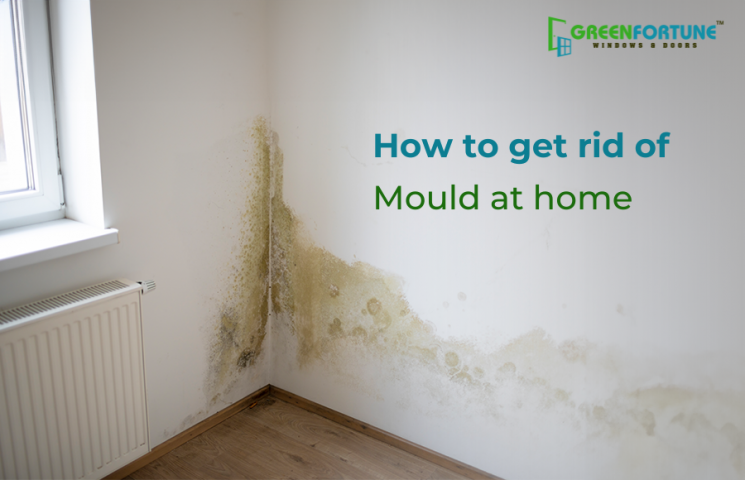
Here’s Why Double UPVC Doors Should Be Your First Choice for a Patio
September 5, 2024
French Balcony Doors: All You Need to Know
September 6, 2024Mould is one of the worst of these plural nemeses. Not only does it look bad, but it's also bad for you. But, worry not, because there are ways to get directly rid of it. Let’s understand what is mould and the steps to get rid of it at your home.
Table of contents
- Understanding Mold
- Identification of Mould-Susceptible
- How to get rid of fungus at home and steps on How to clean small mould patches
- How to get rid of the mould smell in a house
- Locate and Remove the Mould Source
- How to get rid of fungus in room?
- How to prevent mould growth?
- When would you call a professional?
- Conclusion
- Discover GreenFortune, Your Partner in Quality uPVC Windows and Doors
- Frequently Asked Questions
Understanding Mold
Mould is one kind of fungus that grows in regions with much moisture. It canl be seen as black, green, or white patches on walls, ceilings, or other solid matter.
Mould survives in places with highhumidity and inadequate ventilation. Knowing the main places where mould appears will assist in finding it more effectively to take the right actions.
Identification of Mould-Susceptible
Begin by inspecting inside the house at the sweaty places. In bathrooms, kitchens, basements, and attics, most mould tends to form.
Check particularly the regions close to the sinks, showers, and dishwashers. Due to condensation, windows and doors highly hold moulds.
How to get rid of fungus at home and steps on How to clean small mould patches
For small areas of mould, you can do it yourself using ordinary household items.
- First, gather your supplies: rubber gloves, mask, sponge or cloth, and cleaning solutions like white vinegar, baking soda, or a mixture of water with mild detergent.
- Prepare your area at the outset of the cleaning process: good ventilation—open windows if possible—and remove things in your way, that you could bump into.
There are different methods to clean the mould.
Using Vinegar
- Vinegar is a good natural remedy for getting rid of mould at your home.
- Mix a little white vinegar with some water in a spray bottle and spray it directly onto the mouldy area.
- Leave it for about an hour or so to work in before scrubbing with a sponge then rinse with water.
Using Baking Soda
- Mix 1/2 cup of baking soda with water to get a paste.
- Apply it on the mouldy surface with rubbing and later rinse.
- On the other hand, you could add a little mild detergent to water, dig in with a sponge, and clean with fresh water.
- Thereafter, it is essential to wipe everything dry with a clean cloth so the mould does not grow afresh on the same surface.
But if the mould is widespread or has penetrated walls, you may need professional assistance.
Huge mould infestations are not easy to clean and can often be found in between walls, under the baseboard, or above ceilings. Special cleaning equipment and products are necessary to neutralize the mould here.
If the extent of the problem looks beyond the scope of DIY management, by all means, bring on a professional who will be better equipped to handle the situation in terms of technology and skills.
How to get rid of the mould smell in a house
Mold smell can be unpleasant and persistent. It usually indicates that mould is present somewhere in your home. To effectively get rid of the smell, you need to address both the source of the mould and the smell itself. Here’s a guide on how to do it.
Locate and Remove the Mould Source
The smell of mould is a direct outcome of mould presence. You can use the methods outlined above to get rid of mould and after some time the smell should also subside.
If the smell is lingering after you’ve cleared the mould, it can be due to the lingering excess moisture in your home.
You can try opening windows and doors to let your home dry completely to get rid of the smell.
Additionally, you can try the following:
- Use Odour Absorbers Take advantage of natural odor absorbers to eliminate lingering smells.
- The easiest of these happens to be the baking soda.
- Sprinkle it liberally on carpets and upholstery or wherever the smell lingers.
- Let it sit for several hours or overnight, then vacuum up.
Another really good odour absorber is activated charcoal. Place bowls of activated charcoal in areas where the smell has taken hold to begin neutralizing it.
In more serious cases, try using a dehumidifier to get rid of moisture and mould smell.
How to get rid of fungus in room?
Kill the fungus in a room by first killing the underlying moisture problem sincefungi require humid environments to thrive.
- Open windows and set up fans to increase ventilation.
- Clean areas that are infected with a solution of water and mild detergent, or white vinegar, scrubbing away fungus and making sure the surfaces are properly drained. Replace all damaged or deeply infested materials, including drywall or carpet.
- Use dehumidifiers to remove the moisture, and an air purifier can be utilized with a HEPA filter, which is capable of removing fungal spores from the air.
- Continue to check for and correct any leaks or sources of moisture that could lead to future growth.
How to prevent mould growth?
- Control your indoor humidity and increase ventilation in your home.
- Use a dehumidifier when necessary, especially in areas within your home where the relative humidity level can be maintained at under 60%.
- Improve ventilation: install, maintain, and keep in good working condition exhaust fans in bathrooms and kitchens.
- Open windows to allow fresh air in when the weather permits.
- Repair all leaks in your house immediately; outside leaks that are allowed in and are created by a failure in your roof, pipe structure, or walls must be fixed immediately.
- Regular cleaning, especially in the bathroom and kitchen, will stop mould from forming.
Keeping an eye on the noticeable moisture in home moulded house and preventing any further threats will help keep it mould-free.
When would you call a professional?
If you have cleaned, and the mildew keeps reoccurring, or if the mildew extends to an unusually large area, then it is better to approach a professional with the right tools and experience to handle big mould problems safely. An expert can provide speciality cleaning solutions and methods to make certain that the mould is eradicated and does not return.
Conclusion
Mould can be very intransigent, although answering the problem with the right attitude can lend a hand to help how to remove mould from walls and stop its reappearance. Regular cleaning, controlling humidity, and dealing with leaks are the major steps toward keeping mould out of your home. Don't delay—call in some professional help if the situation is rather large to deal with regarding scope.
Discover GreenFortune, Your Partner in Quality uPVC Windows and Doors
At GreenFortune, we are proud to offer high-quality uPVC windows and doors at affordable prices. We offer and install a variety of window types for all homes with both durability and aesthetics in mind.
Contact us to find out more about the uPVC window design that we offer. Whether you are renovating your existing home or building a new one, partner with us to elevate the comfort levels and energy efficiency in addition to the style quotient of your space provided by our superior-quality uPVC windows.
Frequently Asked Questions
Can mould be removed from painted walls?
Yes, you can clean mould off of painted walls. Clean the area first with a solution of mild detergent and water, or if you want to stick with a natural solution, then white vinegar. Take a gentle scrub of the affected area with a sponge or cloth, then rinse and let it air dry thoroughly. If the mould has badly deteriorated or colored the part that you're cleaning, you may be required to paint this area again after cleaning.
When Should One Engage the Services of a Mould Removal Professional?
If it involves a huge mould infestation, covers a large area, or has deeply penetrated materials; such cases are better left to the professionals. Only serious mould infestations would call for professional procedures and equipment to make sure that treatment and eradication are done effectively and safely. If you have tried some DIY approaches but find mould just keeps coming back, a professional will be able to uncover and solve any underlying issues.








